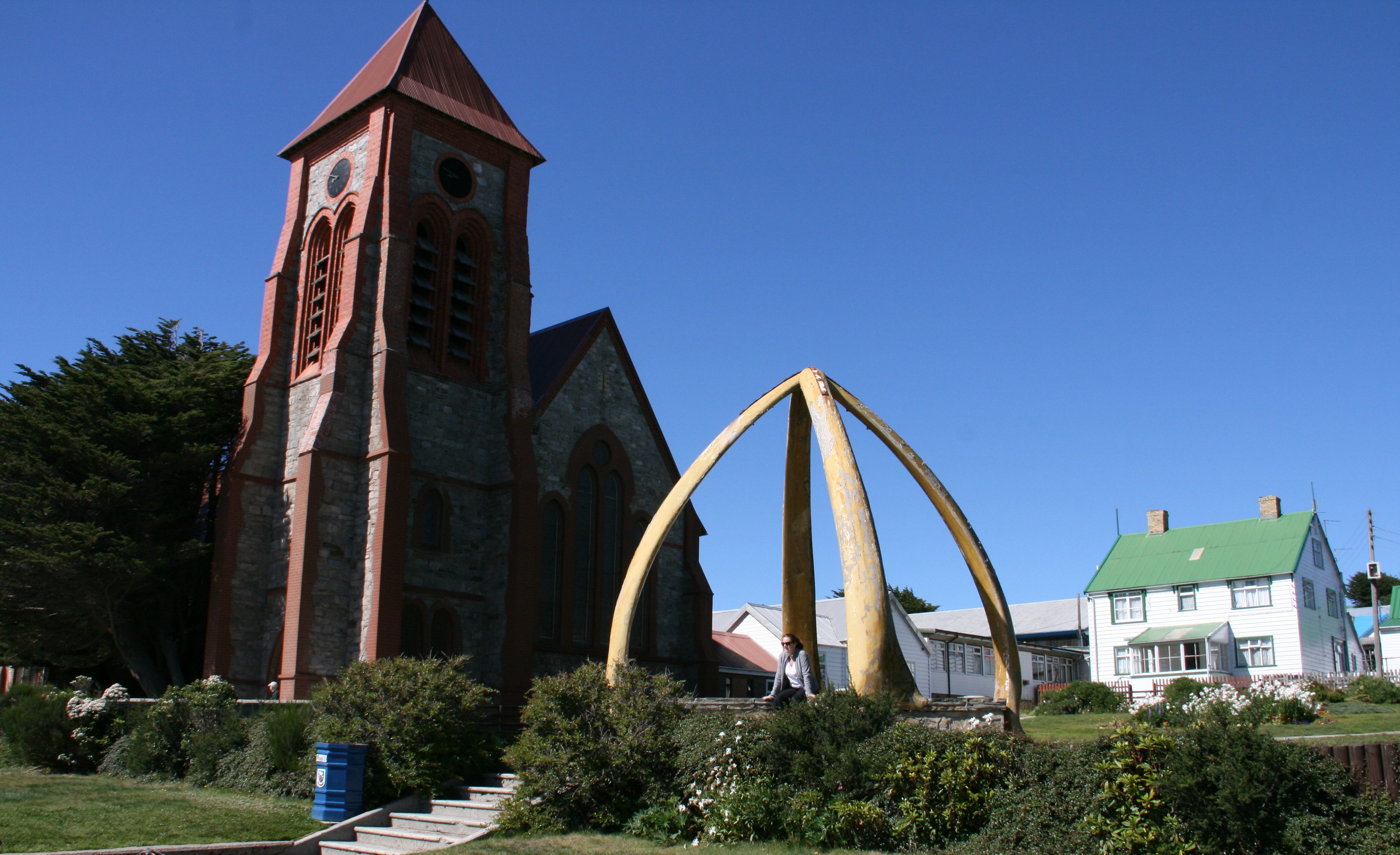FALKLAND ISLANDS
(Falkland Island Flag)
(Falkland Island Map)
MONDAY, FEBRUARY 16, 2009:
All of the images below are thumbnails and can be clicked on for a larger image.
This was the third day of the cruise and the
first of two sea days en route to the Falkland Islands.
9 minute video includes dolphins and Captain's Welcome Reception. |
TUESDAY, FEBRUARY 17, 2009:
This was the fourth day of the cruise and the
second of two sea days en route to the Falkland Islands.
7 minute video includes tour of the ship & fruit carving demonstation. |
WEDNESDAY, FEBRUARY 18, 2009:
We sailed into the Port William, a large inlet on the east coast of East Falkland island,
shortly after sunrise. The Falkland Islands are an archipelago in the South Atlantic Ocean,
located 300 miles from the coast of Argentina. They consist of two main islands,
East Falkland and West Falkland, together with 776 smaller islands.
Stanley, on East Falkland, is the capital.
The islands are a self-governing Overseas Territory of the United Kingdom.
To visit Stanley we tendered through a strait called "the Narrows" into Stanley Harbour.

It was a phenomenal day in Stanley and I had a great time walking around the small town.
The Anglican Christ Church Cathedral is the southernmost cathedral in the world.

Stanley is the capital and only true city in the Falkland Islands. It is located on the isle of East Falkland,
on a north-facing slope, south of Stanley Harbour, in one of the wettest parts of the islands.
As of the 2006 census, the city had a population of 2,115.
In 1982 the islands were invaded by Argentina, precipitating the two-month-long undeclared Falklands War
between Argentina and the United Kingdom, which resulted in the defeat and withdrawal of Argentine forces.
The United Kingdom and Argentina both claim the Falkland Islands (Malvinas).
The town has four pubs, eleven hotels & guesthouses, three restaurants, a fish and chips shop and three churches.
The town hall doubles up as a post office cum philatelic bureau, law court and dance hall.
Approximately 25,000 land mines remaining from the 1982 war are securely and clearly fenced off.
Care should still be taken as some beaches were mined,
and there have been concerns the tides could have moved some mines.
Days this nice in Stanley happen very rarely. We were truly blessed by the weather.
Gypsy Cove, known for its Magellanic penguins, is about four miles from Stanley.
Gypsy Cove and Yorke Bay are a pair of small bays in the Falkland Islands.
The bays face northwards into Port William, and have Canopus Hill behind them.
Because of their strategic position, on a peninsula, not far from Stanley, during the 1982
occupation of the Falklands, the Argentines placed several fields of plastic landmines nearby,
in order to prevent a British landing.
Although the landmines can be set off easily by humans, the bays are filled with penguins,
who have taken advantage of their undisturbed location, and which are too small to set off the mines.
Other birds include oystercatchers, kelp geese, Falkland steamer ducks, rock cormorants and dolphin gulls.
I could see our ship anchored in Port William from Ordnance Point near Gypsy Cove.
In early evening after a fantastic day ashore we sailed away from the beautiful islands.
8 minute video of the penguins at Gypsy Cove. |
Our Captain, who was stationed here while in the navy, said this was the nicest day he had ever seen here.
Surrounded by cool South Atlantic waters, the Falkland Islands have a climate very much influenced by the
ocean with a narrow annual temperature range. January averages about 9°C, with average daily high of 13°C,
while July averages about 2°C with average daily high 4°C. Rainfall is relatively low at about 24 inches.
Humidity and winds, however, are constantly high. Snow is rare, but can occur at almost any time of year.
The Lighthouse on Cape Pembroke (seen in middle photo below) is the easternmost point of the Falklands.
There was a beautiful sunset while sailing away from the Falkland Islands.
11 minute video of the Falkland Islands and the town of Stanley. |
THURSDAY, FEBRUARY 19, 2009:
This was the sixth day of the cruise.
We were sailing between the Falkland Islands and Antarctica.
6 minute video includes icebergs and musicians in the atrium. |

Click on the arrow above to continue to my next adventure, ANTARCTICA.
| TIM'S HOME PAGE SITE INDEX | ||
|---|---|---|
| Areas | Description | # of Pages |
| About Me | Current Picture of me and my home. Information about myself. | 2 |
| Biography | Pictorial biography of myself. Pictures range from birth to adulthood. | 4 |
| Family File | Pictures of my family and a little information about them. | 11 |
| Local Spotlight | Pictures, Links, and Information for Indianapolis, Richmond, Plainfield, and Mooresville, Indiana. | 6 |
| Tim's Travels | Pictures, videos and travelogs from my travels around the world. | 300+ |
| Vacation Videos | Over 1280 videos from my travels around the world. | 1 |